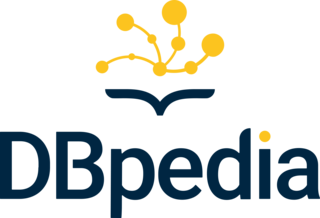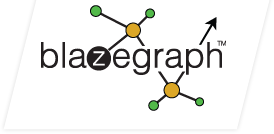Related Research Articles
The Semantic Web, sometimes known as Web 3.0, is an extension of the World Wide Web through standards set by the World Wide Web Consortium (W3C). The goal of the Semantic Web is to make Internet data machine-readable.
Query languages, data query languages or database query languages (DQLs) are computer languages used to make queries in databases and information systems. A well known example is the Structured Query Language (SQL).
SPARQL is an RDF query language—that is, a semantic query language for databases—able to retrieve and manipulate data stored in Resource Description Framework (RDF) format. It was made a standard by the RDF Data Access Working Group (DAWG) of the World Wide Web Consortium, and is recognized as one of the key technologies of the semantic web. On 15 January 2008, SPARQL 1.0 was acknowledged by W3C as an official recommendation, and SPARQL 1.1 in March, 2013.
Oracle Spatial and Graph, formerly Oracle Spatial, is a free option component of the Oracle Database. The spatial features in Oracle Spatial and Graph aid users in managing geographic and location-data in a native type within an Oracle database, potentially supporting a wide range of applications — from automated mapping, facilities management, and geographic information systems (AM/FM/GIS), to wireless location services and location-enabled e-business. The graph features in Oracle Spatial and Graph include Oracle Network Data Model (NDM) graphs used in traditional network applications in major transportation, telcos, utilities and energy organizations and RDF semantic graphs used in social networks and social interactions and in linking disparate data sets to address requirements from the research, health sciences, finance, media and intelligence communities.
Ontotext is a software company with offices in Europe and USA. It is the semantic technology branch of Sirma Group. Its main domain of activity is the development of software based on the Semantic Web languages and standards, in particular RDF, OWL and SPARQL. Ontotext is best known for the Ontotext GraphDB semantic graph database engine. Another major business line is the development of enterprise knowledge management and analytics systems that involve big knowledge graphs. Those systems are developed on top of the Ontotext Platform that builds on top of GraphDB capabilities for text mining using big knowledge graphs.

Eclipse RDF4J is an open-source framework for storing, querying, and analysing RDF data. It was created by the Dutch software company Aduna as part of "On-To-Knowledge", a semantic web project that ran from 1999 to 2002. It contains implementations of an in-memory triplestore and an on-disk triplestore, along with two separate Servlet packages that can be used to manage and provide access to these triplestores, on a permanent server. The RDF4J Rio package contains a simple API for Java-based RDF parsers and writers. Parsers and writers for popular RDF serialisations are distributed along with RDF4J, and users can easily extend the list by putting their parsers and writers on the Java classpath when running their application.

DBpedia is a project aiming to extract structured content from the information created in the Wikipedia project. This structured information is made available on the World Wide Web. DBpedia allows users to semantically query relationships and properties of Wikipedia resources, including links to other related datasets.
A triplestore or RDF store is a purpose-built database for the storage and retrieval of triples through semantic queries. A triple is a data entity composed of subject–predicate–object, like "Bob is 35" or "Bob knows Fred".
Freebase was a large collaborative knowledge base consisting of data composed mainly by its community members. It was an online collection of structured data harvested from many sources, including individual, user-submitted wiki contributions. Freebase aimed to create a global resource that allowed people to access common information more effectively. It was developed by the American software company Metaweb and run publicly beginning in March 2007. Metaweb was acquired by Google in a private sale announced on 16 July 2010. Google's Knowledge Graph is powered in part by Freebase.

Sones GraphDB was a graph database developed by the German company sones GmbH, available from 2010 to 2012. Its last version was released in May 2011. sones GmbH, which was based in Erfurt and Leipzig, was declared bankrupt on January 1, 2012.
GeoSPARQL is a standard for representation and querying of geospatial linked data for the Semantic Web from the Open Geospatial Consortium (OGC). The definition of a small ontology based on well-understood OGC standards is intended to provide a standardized exchange basis for geospatial RDF data which can support both qualitative and quantitative spatial reasoning and querying with the SPARQL database query language.
The Open Semantic Framework (OSF) is an integrated software stack using semantic technologies for knowledge management. It has a layered architecture that combines existing open source software with additional open source components developed specifically to provide a complete Web application framework. OSF is made available under the Apache 2 license.
This is a comparison of triplestores, also known as subject-predicate-object databases. Some of these database management systems have been built as database engines from scratch, while others have been built on top of existing commercial relational database engines. Like the early development of online analytical processing (OLAP) databases, this intermediate approach allowed large and powerful database engines to be constructed for little programming effort in the initial phases of triplestore development. Long-term though it seems that native triplestores will have the advantage for performance. A difficulty with implementing triplestores over SQL is that although triples may thus be stored, implementing efficient querying of a graph-based RDF model onto SQL queries is difficult.
Semantic queries allow for queries and analytics of associative and contextual nature. Semantic queries enable the retrieval of both explicitly and implicitly derived information based on syntactic, semantic and structural information contained in data. They are designed to deliver precise results or to answer more fuzzy and wide open questions through pattern matching and digital reasoning.
The PoolParty Semantic Suite is a technology platform provided by the Semantic Web Company. The EU-based company belongs to the early pioneers of the Semantic Web movement. The software supports enterprises in knowledge management, data analytics and content organisation. The product uses standards-based technologies as defined by W3C, which prevents vendor lock-in. Reference customers are among others Boehringer Ingelheim, Credit Suisse, European Commission, REEEP, Wolters Kluwer and the World Bank Group.
Shapes Constraint Language (SHACL) is a World Wide Web Consortium (W3C) standard language for describing Resource Description Framework (RDF) graphs. SHACL has been designed to enhance the semantic and technical interoperability layers of ontologies expressed as RDF graphs.

Blazegraph is an open source triplestore and graph database, developed by Systap, which is used in the Wikidata SPARQL endpoint and by other large customers. It is licensed under the GNU GPL.

In knowledge representation and reasoning, knowledge graph is a knowledge base that uses a graph-structured data model or topology to integrate data. Knowledge graphs are often used to store interlinked descriptions of entities – objects, events, situations or abstract concepts – while also encoding the semantics underlying the used terminology.

Ontotext GraphDB is a graph database and knowledge discovery tool compliant with RDF and SPARQL and available as a high-availability cluster. Ontotext GraphDB is used in various European research projects.
References
- ↑ "Text Mining & Semantic Technology Running in the Cloud – Welcome to "S4" from Ontotext | NEVEQ".
- ↑ "Getting Started with S4, the Self-Service Semantic Suite « Another Word for It".
- ↑ " @Ontotext_S4 " on Twitter
- ↑ "Archived copy". Archived from the original on 2014-11-11. Retrieved 2014-11-11.
{{cite web}}: CS1 maint: archived copy as title (link)